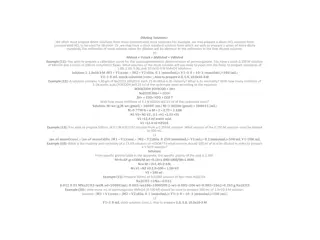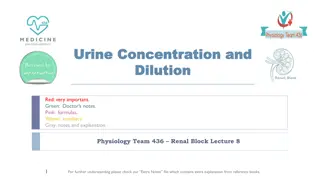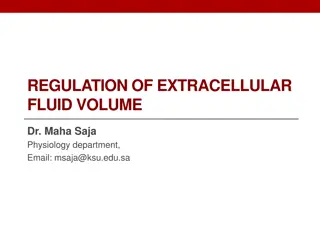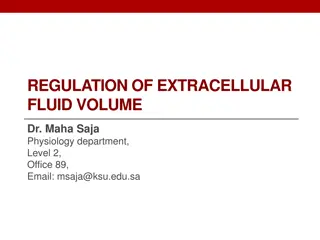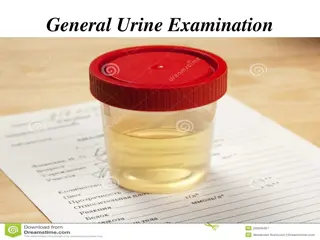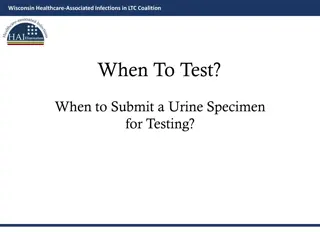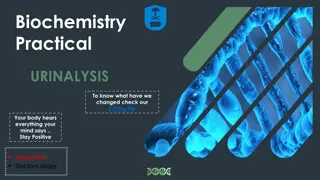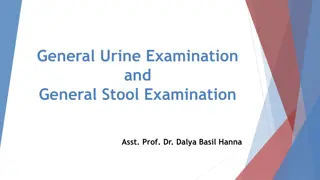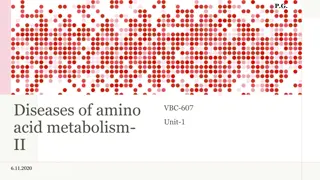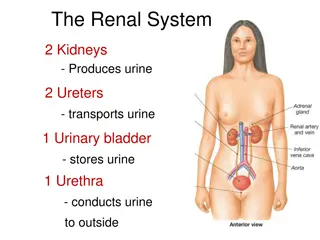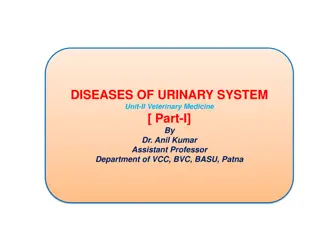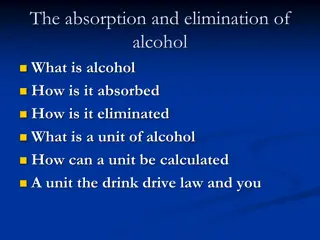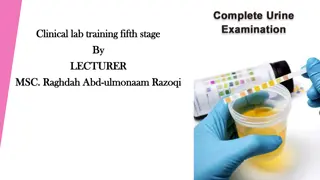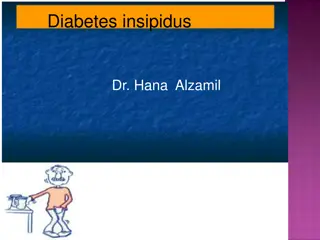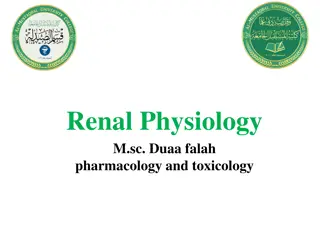Understanding Mechanisms for Concentrating & Diluting Urine in Maintaining ECF Osmolarity
Explore the intricate processes involved in concentrating and diluting urine to regulate extracellular fluid (ECF) osmolarity through mechanisms like the loop of Henle and vasa recta. Understand the factors influencing the ability to create a concentrated medullary gradient, differentiate water diuresis from osmotic diuresis, and appreciate clinical correlations with conditions like diabetes mellitus and diabetes insipidus.
Download Presentation

Please find below an Image/Link to download the presentation.
The content on the website is provided AS IS for your information and personal use only. It may not be sold, licensed, or shared on other websites without obtaining consent from the author. Download presentation by click this link. If you encounter any issues during the download, it is possible that the publisher has removed the file from their server.
E N D
Presentation Transcript
MECHANISMS FOR CONCENTRATING & DILUTING URINE Regulation of ECF osmolarity
Objectives At the end of this session, students should be able to; Identify and describe that the loop of Henle is referred to as countercurrent multiplier and the vasa recta as countercurrent exchanger systems in concentrating and diluting urine. Explain what happens to osmolarity of tubular fluid in the various segments of the loop of Henle when concentrated urine is being produced. Explain the factors that determine the ability of loop of Henle to make a concentrated medullary gradient. Differentiate between water diuresis and osmotic diuresis. Appreciate clinical correlates of diabetes mellitus and diabetes insipidus.
ECF Osmolarity Maintaining a constant concentration of solutes & electrolytes in the ECF is important for normal cellular function. The concentration of solutes in the ECF = osmolarity. Normal ECF osmolarity 300 mOsm/L What determines the osmolarity of ECF? Amount of solute Osmolarity = Water Volume of ECF
Water Balance Simplified version! Input Output Urine
Water Balance Water Balance Daily loss: Insensible loss (700 ml). Sweat (100 ml). Feces (100 ml). Urine (1400 ml). Water intake: Fluids ingested (2100 ml). From metabolism (200ml) Total intake = 2300 ml Total loss = 2300 ml
Regulation of H2O by the Kidney Body water deficit Body water excess Small volume of concentrated urine Large volume of diluted urine Urine osmolarity 1200 mOsm/L 50 mOsm/L
H2O Handling by the Kidney ADH-dependent 65% Hypo-osmotic 300 100 Cortex 300 http://images.all-free-download.com/images/graphicthumb/tick_ok_sign_4190.jpg Isosmotic ADH https://encrypted-tbn1.gstatic.com/images?q=tbn:ANd9GcS5YXBlXZ1vojsAHRTpeldGyolR26xY5sFn7egJUHDRMMLYvRbI ADH Medulla is hypertonic 600 20% Medulla 1200 1200 hyperosmotic What happens to the osmolarity of tubular filtrate?
Obligatory urine volume The minimal volume of urine that must be excreted to rid the body of waste products of metabolism. A 70-Kg human needs to excrete 600 mOsm of solutes per day. What is the obligatory urine volume? 600 mOsm/d = 0.5 L/day 1200 mOsm/L
Forming a Concentrated Urine Requires: 1. High levels of ADH. 2. Hyperosmotic renal medulla. a. Countercurrent mechanism. b. Urea recirculation. IF around the body has an osmolarity of 300 mOsm/L.. How did the renal medullary interstitium become hyperosmotic?
The Vasa Recta Why doesn t the blood flowing through the vasa recta into the renal medulla wash out the medullary hyperosmotic gradient? 1. Medullary blood flow is low (<5%) of renal blood flow. 2. The vasa recta serve as countercurrent exchangers.
REGULATION OF ECF OSMOLARITY
Stimulants for ADH Secretion Osmotic (most important) Osmolarity of ECF. 1% change in osmolarity can alter ADH secretion significantly. Hemodynamic Volume & pressure in the vascular system. 5-10% decrease in BP or BV is required before ADH secretion is stimulated.
Factors That Can Alter ADH Secretion Increase ADH Decrease ADH Nausea ANP Hypoxia Angiotensin-II Drugs; Drugs; Morphine Nicotine Alcohol
Water Balance Firing and send signals to posterior pituitary Release ADH from Post. Pituitary Shrinking of osmoreceptor cells in the hypothalamus H2O reabsorption by kidney Osmolality (Dehydration) Water retention Diluted urine Osmolality=290 mosm/L Osmolality (over-drinking) H2O reabsorption by kidney Osmoreceptor cells in the hypothalamus ADH secretion by posterior pituitary
Feedback Mechanisms Involved in Regulation of Water Balance
Abnormalities in ADH Secretion Abnormalities in ADH secretion Excessive ADH SIADH No ADH effect Diabetes insipidus High ADH levels. Water retention. ECF hypo-osmotic Urine hyperosmotic Nephrogenic Central Mutations in V2 receptors or AQP2. Cannot respond to ADH. Polyuria Polydipsia ADH from posterior pituitary. Polyuria Polydipsia
24 Water Diuresis vs Osmotic Diuresis Water diuresis Osmotic diuresis Increased urine flow rate (No change in urine excretion of solutes Increase urine flow rate as well as the excretion of solutes Causes: - Excess ingestion of water - Lack of ADH - Defect in ADH receptors in Distal segment of nephron (nephrogenic Diabetes Insipidus) Causes: - Increase plasma glucose level (DM) - Increase level of poorly reabsorbed solutes/ anions - Diuretic drugs (Lasix) Diuresis is mainly due to decrease in water reabsorption in distal segment of nephron. No change to the water reabsorbed proximally Diuresis is mainly due to decrease reabsorption of solute in PCT or LOH. Decrease solute reabsorption results in decrease in water reabsorption proximally as well as distally
25 Water Diuresis vs Osmotic Diuresis Water diuresis Increase urine volume results from increased excretion of pure water Osmotic diuresis Increase urine volume results from increased excretion of osmotically active solutes which pulls water with it. Urine osmolality falls far below plasma osmolality. Urine osmolality falls but remains above plasma osmolality. Only about 15% filtered load of water reaching distal segments may remain unabsorbed and excreted in urine (maximum urine volume 20 ml/min) Due to decreased water reabsorption in all segments of nephron, a much greater fraction of filtered water may be excreted volume more than 20 ml/min ADH administration will stop diuresis if it is due to lack of ADH. ADH administration will not be effective in Nephrogenic Diabetes Insipidus. ADH administration will not stop diuresis.


